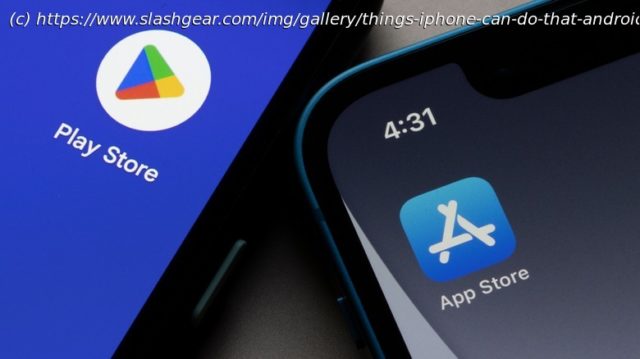When smartphone shopping, you might be wondering whether to get an iPhone or an Android. Well, there are things an iPhone can do that an Android just can’t.
When deciding on your next smartphone, the first question is invariably whether to get an iPhone or an Android. The general consensus was that you go for an iPhone if you want a phone that works without tweaking, with a camera that handles most conditions, and for Android to customize your handset’s feel and look. The gap has been narrowing in recent years. Apple has been adding more user customizability to iOS. Android manufacturers have been locking off bootloader access and adding other security methods like Samsung’s Knox, which locks out some features if a custom ROM is flashed to the device.
Apple has an advantage in that it controls the hardware and the software and has an ecosystem of other devices marketed to lifestyle users. There are many Android manufacturers, so creating a closed ecosystem like this is trickier. The competition is fierce, with new features coming out on one device before the rest of the market copies it for their own. That said, some features exist only on iPhone, which keeps Apple users returning for their next device at upgrade time. We’ve rounded up our favorite iPhone features that Android users can’t access.Use iMessage
The infamous green and blue bubble argument will disappear once Android can use iMessage. Until then, iPhone users will stay with Apple, which the company knows as iMessage was kept exclusive as a retention method. Shame, as it could have been the default standard for messaging across all mobile operating systems. The biggest bonus in the days before unlimited cellular contracts was that iMessage used Wi-Fi or cellular data to send the messages, so it didn’t eat into precious SMS allocations from the carrier. Now SMS messaging is usually unlimited, but users are already hooked on using iMessage and its many other features. The most well-known is its synchronization across devices so that the same messages turn up on iPhone, iPad, Mac, or any other device signed into that Apple ID.
That’s only scratching the surface of the functionality inside iMessage. The service supports inline replies, pinned conversations, and filtering unknown senders into their own inbox. The service is no longer a basic SMS messenger, with the ability to tag participants in group chats, send handwritten notes, share your location with friends and family, send money, and play games with your contacts.Use Continuity Camera to become your webcam
Smartphone users have been able to use their devices as a webcam for their Windows or Mac computers for years. Apps like DroidCam or Camo sync the feed from the smartphone’s camera into the computer, so it looks like a webcam to the operating system. Both options work wirelessly or wired but require additional software installed on your computer and some setup time. There’s also no guarantee they will work with your videoconferencing software, and often require a paid upgrade to the pro option before features like higher resolution and image quality tools are enabled.
With the release of macOS Ventura and iOS 16, iPhone users don’t need to install or set up third-party apps to use their iPhone as their webcam. Continuity Camera requires minimal setup as long as the same Apple ID is signed in on both devices. It’s a matter of selecting the iPhone as the webcam in any Mac app that uses the camera or microphone. That starts the rear-facing camera on the iPhone, feeding its image into the Mac app. Once set the first time, as long as your iPhone is near the Mac, the devices will sync up every time a recording app opens. It also has one feature no other app has, in Desk View. This uses the ultrawide camera to display a top-down view of your desk and your face.Video chat with FaceTime
The deep integration of FaceTime to iOS and its simplicity are big pluses for Apple’s video calling tool. Google generally has a problem with messaging apps and can’t decide if you should use Meet or Duo, with many users preferring third-party options like WhatsApp or Skype. FaceTime is preloaded on iPhones, iPads, and Macs, providing a consistent video-calling experience across all Apple platforms. It could be so much more if Apple would create native apps for Windows and Android so that the rest of the world could use FaceTime. Xerox might be a business relic nowadays, but the name is synonymous with photocopying a document. Google is synonymous with internet searching, and many other brands like Jell-O are now the de facto name for the category of thing they were famous for.
FaceTime could be the king of video calling for personal and business use. All it would take is for Apple to open up its walled garden a little more. There are over 1.5 billion iPhones in daily use worldwide, and that’s a little over 21% of the world’s population, all with a FaceTime-ready device in their pocket. Apple has already started to take advantage of this, with a way to share a FaceTime request to users on Android or Windows so they can connect via their browser. It’s a half-measure, but it could be testing the waters for something bigger.Use SharePlay to watch together
FaceTime can be used to get together with friends and family from far away, but any video calling app can do that. Other video calling apps don’t have SharePlay, enabling watching shows, movies, and videos, listening to music, or doing fitness routines with other people over FaceTime. Apple users can start content while already on a FaceTime call, which is then synced on the screens of everyone on the call so they can watch together while apart. It can also be initiated from inside any of the growing list of content apps, from live streaming to sports to movies and fitness, by sending a FaceTime request from the sharing menu.
To be fair to Android, Google partnered with Samsung to create Google Duo’s Live Sharing feature which is like SharePlay-lite. Because nothing in Android messaging is straightforward, Google Duo is now Google Meet, which enables the Samsung Galaxy S22 range, the Samsung Galaxy Tab S8 series, and Pixel phones to use Live Sharing.






